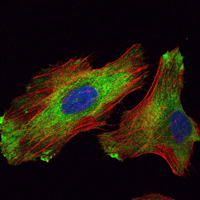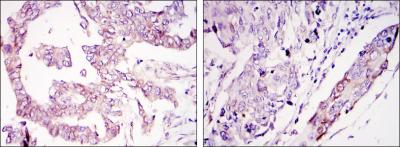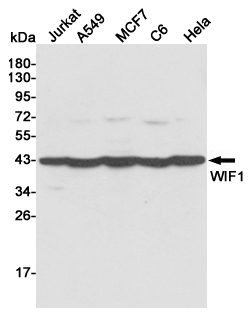-
Product Name
Anti-WIF1 (1D7) Mouse antibody
- Documents
-
Description
WIF1 (1D7) Mouse monoclonal antibody
-
Tested applications
WB, IHC-P, ICC/IF
-
Species reactivity
Human
-
Isotype
Mouse IgG1
-
Preparation
Antigen: Purified recombinant fragment of human WIF1 expressed in E. Coli.
-
Clonality
Monoclonal
-
Formulation
Ascitic fluid containing 0.03% sodium azide.
-
Storage instructions
Store at 4°C short term. Store at -20°C long term. Avoid freeze / thaw cycle.
-
Applications
WB: 1/500 - 1/2000
IHC: 1/200 - 1/1000
ICC: 1/200 - 1/1000
ELISA: 1/10000
-
Validations

Immunofluorescence analysis of Hela cells using WIF1 mouse mAb (green). Red: Actin filaments have been labeled with Alexa Fluor-555 phalloidin.

Immunohistochemical analysis of paraffin-embedded ovary tumour tissues (left) and lung cancer (right) using WIF1 mouse mAb with DAB staining.

Western blot detection of WIF1 in Jurkat,A549,MCF7,C6 and Hela cell lysates using WIF1 mouse mAb (1:500 diluted).Predicted band size:42KDa.Observed band size:42KDa.
-
Background
Swiss-Prot Acc.Q9Y5W5.The protein encoded by this gene functions to inhibit WNT proteins, which are extracellular signaling molecules that play a role in embryonic development. This protein contains a WNT inhibitory factor (WIF) domain and five epidermal growth factor (EGF)-like domains, and is thought to be involved in mesoderm segmentation. This gene functions as a tumor suppressor gene, and has been found to be epigenetically silenced in various cancers.
Related Products / Services
Please note: All products are "FOR RESEARCH USE ONLY AND ARE NOT INTENDED FOR DIAGNOSTIC OR THERAPEUTIC USE"
